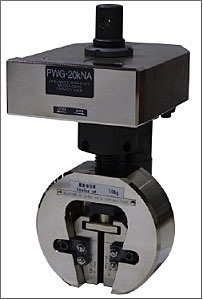Pneumatic Non-Shift Wedge Grips

Features:
- Applicable for testing a wide variety of materials, including metals, plastics, and composites
- Pneumatic action applies a constant clamping force to minimize specimen slippage
- Grips with maximum capacity up to 300 kN (66,000 lbf)
- One-touch chucking by use of a foot valve unit
- Compatible with a comprehensive selection of grip faces for testing rods, wires, materials with high hardness, and composite materials
Relevant Materials:
Plastics, Metals, Composites
Relevant Specimens:
Plates, Rods, Wires
Pneumatic non-shift wedge grips have an open-front design and use one-touch chucking by foot operation to provide simple specimen mounting. These grips are suitable for tensile testing materials such as plastics and metals.
Grip sets include upper and lower pneumatic non-shift wedge grips and file-teeth grip faces for gripping flat plate specimens. To operate the grips, a foot valve unit is required, and to connect the foot valve unit with an air compressor, a rubber hose is needed. Both are available as accessories.
Pneumatic non-shift wedge grips are operable at air pressures between 0.4 MPa (4 kgf/cm2, 58 psi) and 0.6 MPa (6 kgf/cm2, 87 psi). Additional grip faces for testing rods, wires, high hardness materials, and composite materials can be found in the document on Grip Faces for Manual and Pneumatic Non-shift Wedge Grips.
In certain regions, pneumatic non-shift wedge grip kits, which include upper and lower grips, file-teeth grip faces, a foot valve unit, and a rubber connecting hose, are available. In addition, an air compressor might be available as an accessory. Please contact your local Shimadzu representative for availability.
Additional items needed for operation:
- Foot valve unit
- Rubber connecting hose
- 0.5 MPa (5 kgf/cm2, 73 psi) to 0.99 MPa (10 kgf/cm2, 144 psi) air compressor
News / Events
-
AUTOGRAGH AGS-X2 Series has been released
The Shimadzu AUTOGRAPH AGS-X2 series provides superior performance and practical testing solutions for a wide array of applications. Offering high-level control and intuitive operation, the AGS-X2 series sets a new standard for strength evaluations while providing the utmost in safety considerations in a modern, stylish design.
-
AUTOGRAGH AGS-V Series has been released
Shimadzu Corporation released the Autograph AGS-V Series precision universal testing machine. In this series, the range over which the force measurement accuracy is guaranteed has been increased by a factor of two compared with existing machines. As a result of this new function, the work required to change force measurement sensors and accessories required for measurement can be reduced.
-
High-Speed Video Camera HyperVision HPV-X3 has been released
Recording speed of 20 million frames/second, the highest in its class provides larger, clearer, high-sensitivity recording. HPV-X3 is equipped with a synchronized recording function and high-level analytical capabilities that accommodate a variety of software programs.
-
New Video: AUTOGRAPH AGX-V2 Voice Operation Device XV-Talk
We will introduce how XV-Talk, the world's first voice control device installed in Shimadzu's latest tensile tester AGX-V2, can be used in various scenarios.
-
New Video: AUTOGRAPH AGX-V2 Operation Control Panel Stand-alone test feature
We will introduce a new feature of Shimadzu's latest tensile tester, AGX-V2, a stand-alone testing function using a large color LCD touch panel.
-
New Autograph AGX-V2 Series Precision Universal Testing Machines
The World’s First Testing Machines Equipped with a Voice Operation Device


